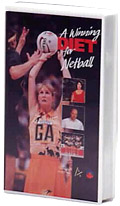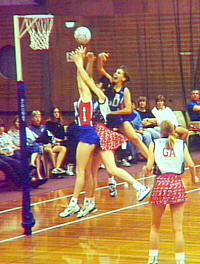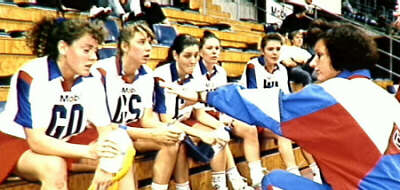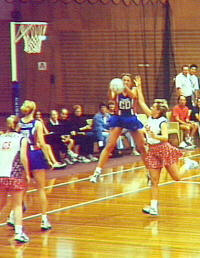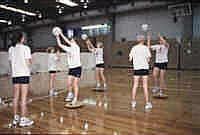 | ||
 |
||
|
| ||
 |
||||||||||||||||||||||||||
Netball Characteristics of the Sport Netball games consist of four 15 minute quarters. There is a 3minute break between the first and second quarter and third and fourth quarter and a 5 minute break between halves. Netball teams may consist of up to 12 players with 7 players on the court at any one time. Each player has a specific position with a defined role and a defined court space. There is no limit to the number of substitutions provided players do not exceed the 12 players named for the match. Netball can be played indoor or outdoor with the trend being to move indoor in recent years. At the elite level, netball is fast-paced, and skilled. Considerable demands are placed upon anaerobic energy systems, with aerobic fitness assisting recovery between bursts of play. Training Training loads vary according to time of the season and the number of games played each week. During the competitive season, elite teams will normally have 3-4 team sessions per week, plus individual sessions. At the non-elite level, training loads vary. Competition Elite netball players tend to be active throughout the year. The Commonwealth Bank Trophy runs from April to August and International and Tri series fill out the year. Elite competition may involve a single game per week or a weekend 'away' tour. At lower levels, summer and winter competitions are generally scheduled. Recreational athletes are often involved in a number of rosters involving a couple of games each week. At the recreational level, games may be played in the evenings midweek or on weekends. Physical characteristics Netball players are generally above-average height. Some positions allow for shorter players, particularly where the ball is played close to the ground. Lower body fat levels are an advantage in improving agility and speed, and with assisting movement off the ground. The body fat levels of elite players may be relatively low, reflecting both the training load and the advantages of being lean. At lower levels of play it is possible to be skilled but less trim and fit. Common Nutrition Issues The training diet A single game of netball does not provide a great threat to the fuel capabilities of trained athletes. However, a combination of regular training sessions and games throughout the week poses a challenge to the recovery of netball players. At the elite level, athletes have not yet reached professional status. This means players have to juggle the demands of training and competing with full time jobs or study. It is essential for netball players to take an organised approach to nutrition. The following tips may help:
Iron status Iron is an important nutrient for growth. Impact against other players or the floor may increase iron losses through increased red blood cell destruction. Some players may have problems with low iron status especially females with low iron intakes. Iron levels should be checked regularly when in heavy training. Iron-rich foods such as lean red meat and breakfast cereals fortified with iron (e.g. Kellogg's Sustain) should be included regularly in the diet. Iron-rich plant foods such as wholegrain cereals, spinach and legumes should be combined with animal iron sources (e.g. wholemeal pasta and bolognaise sauce) or vitamin C sources (a glass of juice consumed with breakfast cereal) to improve iron absorption. A sports dietitian will be able to provide specific dietary help. Game preparation - the pre-event meal The pre-game meal should fuel and hydrate players, but leave them feeling comfortable for the game. Ideally, the menu calls for high-carbohydrate choices eaten at least 2-3 hours before a game. Pasta with low-fat sauces, rolls or sandwiches, baked potatoes with low fat fillings, creamed rice, and fruit salad with yoghurt, are all examples of suitable choices. Remember to include a source of fluid with the pre-game meal. Each player or team should experiment to find the routines that work best for their situation. Eating together as a team can be a great way to raise team morale and get focused for the game. It also ensures that all players have their pre-game nutrition needs looked after. Fluids during training and games Many people think that fluid losses aren't a major consideration in "winter sports". However, high-intensity exercise in a controlled atmosphere stadium can lead to large sweat losses - especially in bigger players. Netball is a game of high-intensity running which also requires skill, concentration and decision-making. These factors can be impaired by dehydration and reduced blood glucose levels. Sports drinks are an ideal choice for netball games and training sessions. They promote better hydration and provide a fuel source to maintain blood glucose levels. Studies of fluid balance in AIS netball players during training and matches showed the following results. Although some players drank well in comparison to their sweat losses, other players needed to try harder to improve their hydration level. Note that sessions undertaken in winter months still resulted in substantial fluid losses.
Does it matter what you drink during training? - A case study The AIS netball team is given free access to sports drink and players are well educated regarding the value of sports drinks. However, our netball players were observed to be very poor users of sports drinks. Netball players strive to maintain a lean body mass - motivated partly by the performance advantages of being lean and partly by a desire to look good in the body suit-style uniforms recently introduced to the sport. It was speculated that netball players may be avoiding sports drinks in order to limit their kilojoule intake. A study was set up where netball players were provided with either water, flavoured regular sports drink or a flavoured low kilojoule ('diet') sports drink during training sessions. Sweat losses of players were monitored by weighing players before and after training. Fluid consumption was monitored and compared to sweat loss to determine fluid balance. Some individual players were found to achieve better fluid balance when using the low kilojoule fluid. However, as a group, players achieved better fluid balance when using either of the two flavoured drinks regardless of the kilojoule content. The study demonstrated that netball players benefited from consuming a flavoured drink, such as sports drink, despite claiming to prefer to drink water. Although some players were concerned about the kilojoule content of sports drink, we reminded them that sports drinks benefit performance and allow players to train more productively. If players need to cut back on kilojoules, it is better to focus on cutting back on other energy dense sources such as cakes, chocolate, icecream and chips, rather than avoiding sports drinks. Netball offers plenty of opportunities for players to hydrate during games. Time outs, quarter- or half-time breaks, and time spent on the bench can all be used as opportunities to consume fluid. During training, coaches need to schedule frequent drink breaks and actively encourage hydration. When comparing netball and basketball teams at the AIS, it was found that basketball players achieve better fluid balance than netball players. This has been attributed to the fact that basketball coaches include regular breaks in training specifically for the purpose of allowing players to drink. In comparison, netball teams have been observed to have less frequent breaks - and these breaks are primarily for the purpose of providing coach feedback rather than having a drink. Players should take responsibility to have their own drink bottle courtside, so that they can keep track of how much they are drinking. In professional teams, the job of refilling bottles is often left to team manager or other support staff member. Post-game recovery tactic Effective recovery begins with the intake of fluid, carbohydrate and other important nutrients. Left to chance, recovery eating may take a back seat to the post-game meetings, stretching and injury treatment, drug testing, media interviews, or the trip back to home or the team hotel. Many teams organise post-game recovery snacks that can be consumed simultaneously with these activities - sports drinks, liquid meal supplements, fruit, sandwiches and cereal bars are some of the many quick options. Depending on the time of the game and the athlete's appetite, this post-game snack may be supplemented by a later meal. Tournament nutrition and road trips As soon as the match schedule is known, plan a meal routine that schedules appropriate pre-event meals and recovery strategies. When several games are played in succession over as many days, pro-active recovery techniques will be important in maintaining performance right through the end of the schedule. If you are playing away from home, plan where you will be eating meals, and organise the menus in advance. It is stress-free when a hungry team arrives at a restaurant to find buffet-style meals waiting, tailor-made to their special needs. Similarly, take control of meals eaten on planes, buses and other travel options. Always carry some high-carbohydrate snacks such as cereal bars, fruit and yoghurt for emergencies. In hotels, empty the mini bars to make room for more nutritious snacks and drinks.
The AIS Department of Sports Nutrition has produced a video on nutrition for netball titled A Winning diet for netball. You will find details and ordering information on our Resources - Videos page.
You will find more information about netball at the
Australian Institute of Sport on the
|
| |||||||||||||||||||||||||
|
The Department of Sports Nutrition is a program of the
Australian Institute of Sport General enquires can be emailed to: aisnutrition@ausport.gov.au Copyright
© Australian Sports Commission
| ||||||||||||||||||||||||||

